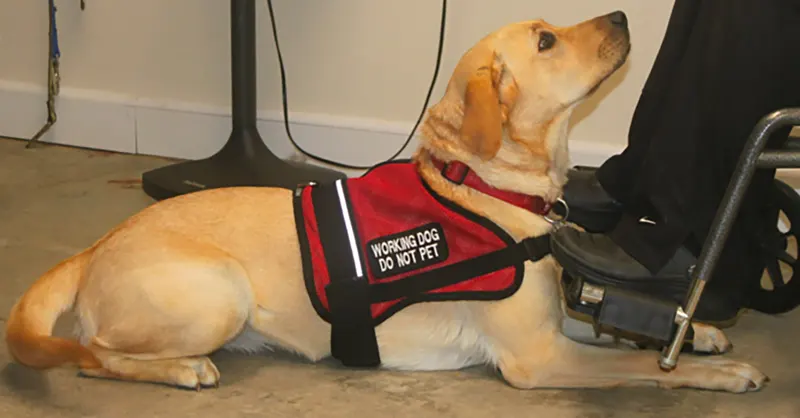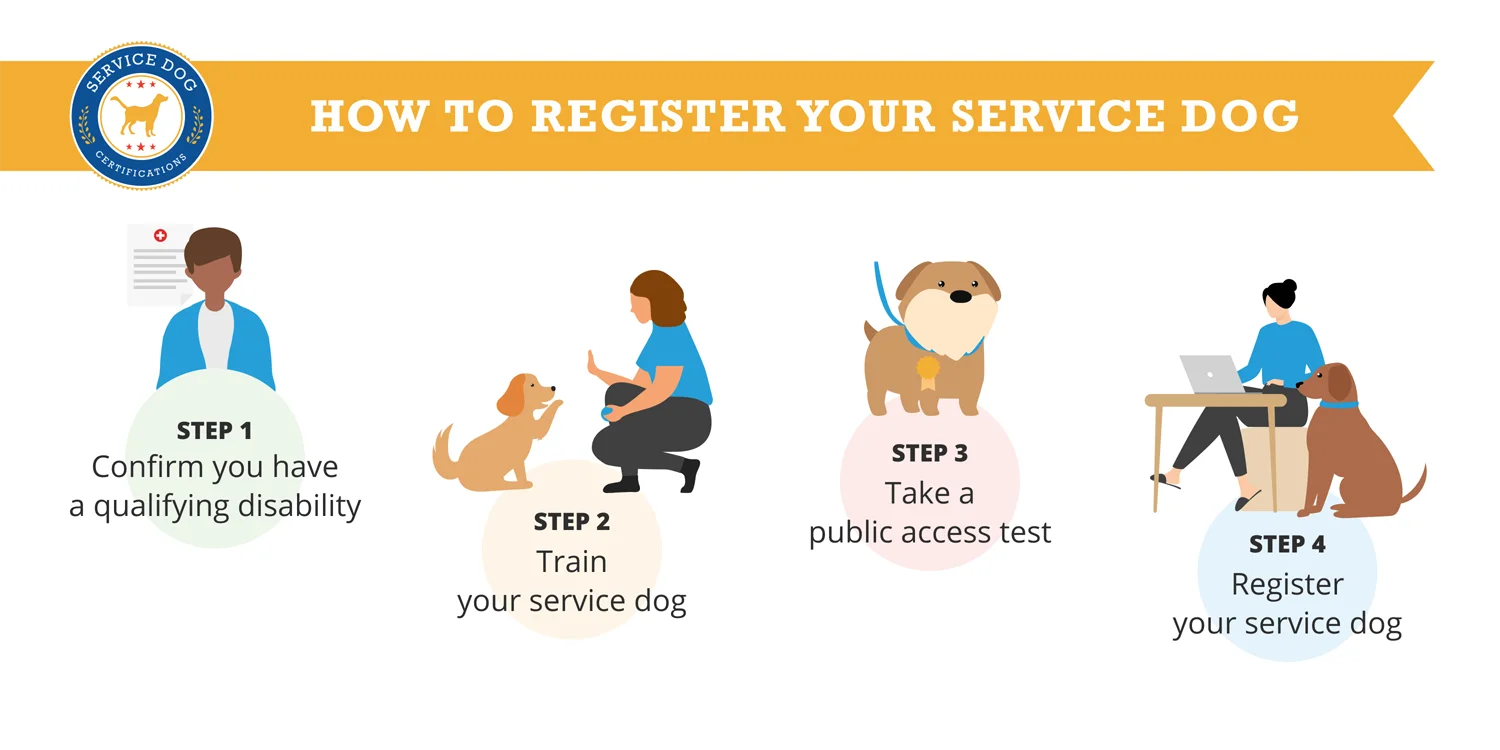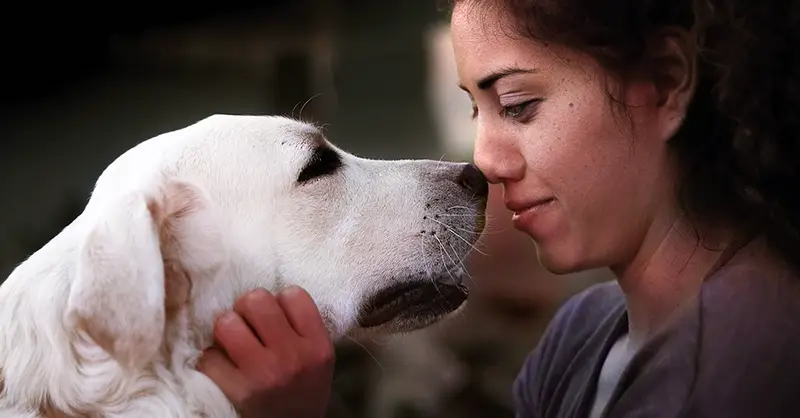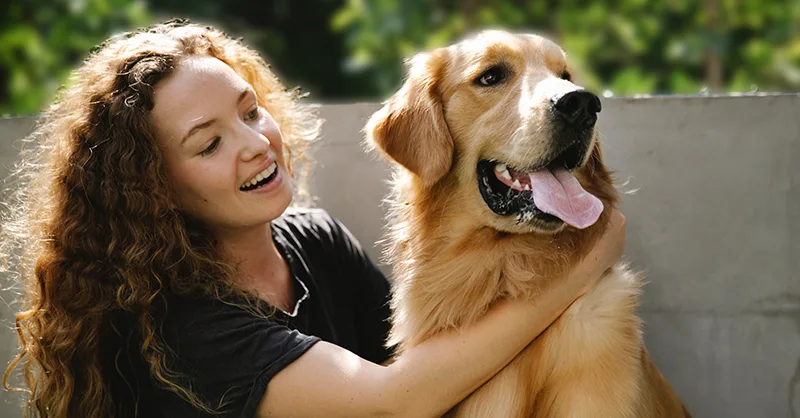Home Page › Blog › Service Dog Requirements
Service Dog Requirements

The ADA defines a Service Animal as a dog individually trained to perform tasks or do work for the benefit of a person with a disability. A disability can be a physical impairment, but the ADA also includes mental illnesses that substantially limit one or more major life activities, such as depression, severe anxiety, or PTSD.
This article will cover the qualification requirements to be a Service Dog handler, what training and tests can be expected for your Service Dog, and what to expect when in public. After covering the legal rights of Service Dogs, we’ll present options for facilitating interactions with the public, including specialized Service Dog accessories and identification.
What are the Service Dog requirements?
Training a dog to become a service animal is available to individuals who have a disability. If you are interested in having a service dog, below are requirements to be aware of:
Eligibility: A person is eligible for a service dog if they have a physical, emotional, or mental health disability
Training: The dog must be trained to take a specific action when needed to assist the person with a disability. The task(s) performed by the dog must be directly related to the person’s disability. The ADA does not require professional training; people with disabilities have a right to train the dog themselves.
Behavior: A service dog must be under its handler’s control at all times.
Verification: If it is not obvious what service the dog provides, the handler must be willing to answer two questions about their service dog. These two questions are: (1) is the dog a service animal required because of a disability? and (2) what work or task has the dog been trained to perform? Staff are not allowed to request any documentation for the dog, require that the dog demonstrate its task, or inquire about the nature of the person’s disability.
Identification: Optionally, it can help service dogs to be clearly identified with accessories like ID cards, vests, tags, and certificates.
How does my dog become a Service Dog?
Consider these four simple steps to help you understand how your dog can become a service dog.
- Determine if you have an eligible disability
- Train your Service Dog
- Pass a Public Access Test
- Consider Service Dog Certification and Registration
Service Dogs serve an important function for those in our community who need special care. It’s crucial for both Service Dog handlers and the general public to be aware of what Service Dog requirements are.
Step 1: Determine if you have an eligible disability
Under the ADA, you must have a qualifying condition to have a Service Dog. The condition can take many forms (physical, mental, etc.). Physical disabilities include conditions like visual impairment, limited mobility, and hearing loss. The physical or mental impairment must substantially limit a major life activity like the ability to work, move about, socialize, or sleep.
Some common conditions that qualify for Psychiatric Service Dogs are anxiety, depression, and PTSD, but this list is not exhaustive. For psychiatric disabilities, a common first step is to be evaluated by a Licensed Mental Healthcare Practitioner (LMHP) who can write a letter confirming your eligibility. These PSD letters typically have the following traits:
- written on the licensed healthcare professional’s letterhead
- dated and signed by the professional
- contain the professional’s contact information, license number, license date, and state of licensure
- contain the professional’s opinion on whether you have a mental or emotional disability that can qualify for a psychiatric service dog
Step 2: Training your Service Dog
To be considered a Service Dog, a dog must be individually trained to perform a job or task relating to your disability. Be aware that there is no official organization that sets training standards in the U.S. You are not required to work with a trainer – the ADA allows handlers to train their dogs on their own.
While there’s no minimum requirement in the US, some private standards suggest approximately 120 hours over six months. Some sources recommend that at least 30 hours (about ¼ of the time) be spent in public to help train the dog for moments of distraction and when surprises come their way. While not required, it can be helpful for Service Dogs to wear relevant accessories so that people in public can adjust their behavior accordingly.
The most important thing for you to teach your Service Dog is tasking or learning the specific skill they will be performing to help assist with your disability. There are countless tasks Service Dogs are called on to perform, including guiding the visually impaired, pulling a wheelchair, sensing a medical alert, tactile stimulation during a panic attack, reminding the handler to take their medication, scouting a room for someone with PTSD, or grounding/blocking in public areas.
Step 3: Pass a public access test
In addition to training your dog to perform tasks that assist with your disability, it is important for a service dog to be able to comport itself appropriately in public by passing a public access test.
Public Access Criteria:
- No aggressive behavior towards people and other animals.
- Refrain from sniffing behaviors unless released to do so.
- No solicitations for food or affection while on duty.
- No over-excitement and hyperactivity in public.
- Able to tolerate novel sights and sounds in various public settings.
- No unruly behavior or excessive barking.
- No relieving themselves in public without being given a specific command.
Once your dog is properly trained, your next step is to decide how you prefer to identify your service dog.
Step 4: Service Dog Certification and Registration
In the United States, service dog certifications and service dog identifications are not legally required. Staff at a public establishment cannot solicit documentation, such as proof that the animal has been certified, trained, or licensed as a Service Dog, as a condition for entry.
Despite the limited verification requirements established by the law, staff at many public establishments will still insist on IDs or other tangible proof of Service Dog status. Service Dog handlers often find it helpful to have documents and accessories that help signal that their dog is trained and at work in order to prevent being met with hostility and confusion.
Electing to carry a custom Service Dog ID card and Service Dog Vest may be helpful tools for you and your service dog to navigate public spaces. You may also choose not to carry the ID card and stand your ground on principle when you encounter people ignorant of service dog rights. Under ADA rules, staff at a venue may only ask two questions if the handler’s disability is not apparent: (1) is the dog a service animal required because of a disability? and (2) what work or task has the dog been trained to perform?

After you verbally confirm that your dog is a trained service dog, reasonable accommodations must legally be made for service dogs. Service Dogs can go anywhere their handlers can go, provided they do not pose a health or safety hazard to others. If a particular service animal behaves in a way that poses a direct threat to the health or safety of others, has a history of such behavior, or is not under the control of the handler, that animal may be excluded. If an animal is excluded for such reasons, staff must still offer their goods or services to the person without the animal present. It’s important to understand these rules so you know what rights you have as the owner of a Service Dog and when third parties are violating your rights.
You’re all caught up on what it takes to have a Service Dog!
Ready to register and ID your dog?
Unable to train your dog as a service dog?
You may be interested in an Emotional Support Animal instead. ESAs do not require specific training, have access to no-pet apartments, and are exempt from breed or weight restrictions. Click here to learn more about ESAs.
In short, ESAs are protected under Federal Housing Regulations (but not the ADA), meaning that you cannot be charged any pet rent, deposits, or fees, nor can you or your ESA be denied housing on the grounds of living with a pet, with very few exceptions.
To qualify for an ESA, you must have a licensed mental health practitioner (including, but not limited to, psychologists, therapists, social workers, GPs/PCPs, etc.) write a letter affirming that you have a qualifying condition (including, but not limited to, depression, anxiety, PTSD, etc.) that is helped by an emotional support animal. Additionally, unlike Service Animals, ESAs do not necessarily have to be dogs; cats, rabbits, and birds are other common choices.
¿Quieres leer este artículo en español?
Puede encontrar una versión traducida al español de los requisitos para perros de servicio aquí.
Want to read this article in Spanish?
You can find a Spanish translated version of Service Dog Requirements here.
About the Author: The writing team at Service Dog Certifications is made up of folks who really know their stuff when it comes to disability laws and assistance animals. Many of our writers and editors have service dogs themselves and share insights from their own experiences. All of us have a passion for disability rights and animals.
439 comments
Leave a Reply Cancel reply
Latest Posts

How to Bring a Service Dog to Disneyland
Trained service dogs are more than welcome to join their handlers at Disneyland. In this guide, we’ll explain Disneyland’s policies and give practical advice for bringing a service dog to Disneyland for the first time. Disneyland’s Service Dog Policies The Magic Kingdom is happy to welcome trained service dogs across most park locations! They kindly […]

Read More

Can Dogs Eat Tomatoes?
Yes! Dogs can safely enjoy tomatoes, but there are a few risks to be aware of so you can feed your dog responsibly. Fully ripe tomatoes (without the stems and leaves) can actually have nutrients that are good for your pup. Tomatoes have chlorogenic acid, an antioxidant that can have anti-inflammatory effects in cells. They’re […]

Read More

Can a Primary Care Doctor Write an ESA Letter?
Your family doctor, also called a primary care physician (PCP), can write a letter recommending an emotional support animal. We’ll explain what legally gives them that ability and explore what better options might be available for you. Why are Physicians Able to Write an ESA Letter? To turn your pet into an emotional support animal, […]

Read More







Thank you for this information! Im getting two puppies and I would like to have 1 be serviced trained and 1 therapy trained for my children with Autisim and ADHD.
Thank you for assisting SO many GOOD QUALITY FOLKS
W/THE FACTS THAT MAH EMPOWER THEM W/KNOWLAGE
OF THE RULES – SO THEY ARE ABLE MAINTAIN HEALTHY
LIVES BEING A MEMBER OF SOCIATY THAT DEFF DOES
NEED TO KNOW THE LAWS BETTER.. MY SERVICE DOG HAS
ABSOLUTELY BEEN THE SAVIOR OF MY LIFE ON MORE THEN
A HANDFULL OF AWKWARD, TRYING TIMES. I AM BLESSED
TO HAVE SUCH A GUARDIAN. THOUGH I FEEL IT SHOULD BE
ME LOOKING OUT FOR HER- I JUST KNOW BY THIS & FOLLOWING
THROUGH W/IT ALL THAT IS ME DOING WHATS RIGHT & BEST FOR
HER AN DOUR LIVES.. THANK YOU FOR ADVOCATEING AND BEING
THERE FOR US IN (OUR) TIMES OF NEED.. MAY THEY BE OF THE PAST
OR THE MOMENT 1IS REACHING OUT FOR AID & KNOWLEGE..
THANK YOU ALL.
GODSPEED
ANDREW y LOCA
I was looking into my male chocolate lab dog being bred for potential service dogs. He has a definite need to work. We got him for duck hunting , which he is excellent at, but this is only seasonal. Otherwise he is just a big ol indoor pet. It is his nature and desire to work that interests me in seeing him help bring puppies into a world to help people. I am not wanting anything in exchange for breeding him. I don’t know if there is a need for studs, but if anyone knows of such please let me know.
Hello, I am Bi-polar and have Fibromyalgia and also a rare disease called Achalasia. I cannot be around stress as it affects my eating. I suffer panick attacks and going through this Covid 19 caused me a lot of stress and depression and slight agoraphobia now. I have a Pomchi (Pomeranian x Chihuahua
aged 2 and a half . I feel I can not go out anywhere without him. I live in the U.K . Would my dog be able to be a service dog or assistance dog?
The information on this site is based on US law and regulations. For the U.K. You may try to search for U.K. specific resources that can help you get the answers you need. Take care and stay strong thru these difficult times.
Hi my name Andrea my friend name is wido A Chihuahua I save him from a terrible family that had two pits two big chihuahuas and two cats poor wido don’t get anything to eat a neighbor boy would throw him and kick him when I saved him was all bone it took me six hours for him to come to me but he was stil scared of me know his by my side all day he sleeps with me I have been going through a lot for the past year or so it like he know something wrong because he moves my hand and climbs on my chest when I cry he Licks my tears I need your help getting Wido my emotional care dog I don’t want to lose him it makes me feel real sad but his there Nikki my my tears away
Wido sounds like a lovely partner. In order to get make Wido an emotional support animal (ESA), you would need an ESA Letter, issued by a licensed healthcare professional. This letter can be written by your therapist (if you have one) or through a legitimate online provider where you will be connected with a therapist licensed in your state. They will assess your need for an ESA thru telemedicine sessions.
You may find this article on how to get an ESA letter interesting https://www.servicedogcertifications.org/how-to-get-an-emotional-support-dog-letter/
Wish you both best of luck!
Hi, I want to get my dog certified as a service dog. What do I need to do first. Do I just buy the kit where they sale the I’d cards, the vest and certicate or do I also need to do it threw my Doctor. Please help, I like to take my dog every where I go, I am a lonely person who needs to be always with my dog.
If your dog performs a specific task to benefit a disorder, you may be eligible for a service dog. But to legitimately own a service dog, your dog would need to remain at your side at all times and perform the specific tasks that help you in times of need.
If your dog mainly offers comfort, you could ask your doctor for an ESA letter. This letter would allow you to bring your dog along on travels. You may find this article interesting on the differences between service dogs and emotional support dogs – https://www.servicedogcertifications.org/difference-service-dog-emotional-support-animal/
I want to train my dog to become a service dog but when I take her to public places for training, do I go shards and buy the best and ID card?
Ahead* vest*
A service dog in training is technically not a service dog, yet. Only once your dog can perform the task needed, it can officially be called a service dog. Therefore, it might be too early to order an ID. You can order a vest with a patch saying “Service Dog in Training”. That can help prevent other people from approaching and disturbing your training session. You may find this article on service dog requirements and training interesting https://www.servicedogcertifications.org/service-dog-requirements/ . Crossing my fingers for your dog to become a service dog quickly.
What kind of test does the dog have to pass
I would like to know the answer to this lady’s question
There is a huge difference between service dogs and emotional support dogs. Having a dog with you because you are lonely only qualifies as an Emotional Support Animal or ESA. Service dogs go through several years of training and you must have a noted disability from your doctor stating that a service dog will help you with your disability. No disability means No service dog. Contrary to what this article has said, service dogs have around 3 thousand hours of training, not 120 hours. 30 hours of public access training is only the first week with years to follow. You should check into getting an ESA letter from a qualified & licensed therapist but this does not allow you to bring your dog into restaurants, grocery stores or any other non-pet friendly establishments. An ESA letter is good for airline travel and housing situations only.
Hope this helps.
It is illegal to certify a dog as a service dog
No, it is not illegal. Registrations are not required by law, however many service dog owners feel they run into fewer problems when out in the public when their service dog is registered and has the ID to prove it. You may find this article on how to register your service dog interesting https://www.servicedogcertifications.org/how-to-register-service-dog/
If you don’t have a disability of any kind you do not need a service dog service dogs are medical equipment and if you bring your untrained house pet to public places that puts REAL service dogs at risk for your house pet to attack them it’s wrong and this kit is fake anyways
Go to this great site. It answers all your questions.
https://www.servicedogcertifications.org/service-dog-requirements/
When you need assistance in training your dog or puppy to be obident, we are the experts that you need. We also provide service dog programs as well!
Hi do u take the dog and train or will I have to be available as well
Hi, I am young, and looking to train my dog to be a service dog for PTSD, I have anxiety disorder, ocd, trauma, and take medication… I am terrified of being touched by ppl, even though I am asking for a ptsd service dog, I was never in the military, and I understand that ppl who have had a traumatic event happen in their lives, can qualify for a ptsd service dog, I’d like to train my dog myself, but currently have no idea of how to go by it, I understand the can help with hug on cue, grabbing heavy blankets and pillows, looking around the house when we feel hypervigilant, and blocking/ making ways through crowds, and I just have no idea how to train my dog to do that kind of stuff. I don’t have good money for a trainer, and am currently too afraid to confront new ppl.
PTSD can come in many forms and does not need to be military-related, so do not worry about asking for what type of help you would need from your service dog. You may look online for video tutorials or books on how to train your dog. Depending on your relationship with your dog and how willing your dog is to serve your needs, training yourself will involve more or less time and patience. You may find this guide with some basic service dog training interesting.
https://www.servicedogcertifications.org/service-dog-training-guide-the-basics/
I have anxiety, once in a while I have anxiety attacks and I am in recovery from an eating disorder which even though I put on a brave face gives me anxiety in restaurants more than my normal anxiety.Which would be better an ESA or a service dog. Would I be able to qualify for a service dog?
I forgot to mention that I have mild OCD
If you experience most of your attacks in public places, you might need a service dog, as, by law, ESAs do not have access to public establishments. Some restaurants and shops are ESA friendly, but by far not enough. On the other hand, a service dog can accompany you anywhere but must go through extensive training and be under your control 24/7. You may find this article on the difference between psychiatric service dogs and emotional support animals interesting: https://www.servicedogcertifications.org/the-difference-between-a-psychiatric-service-dog-and-an-emotional-support-animal/